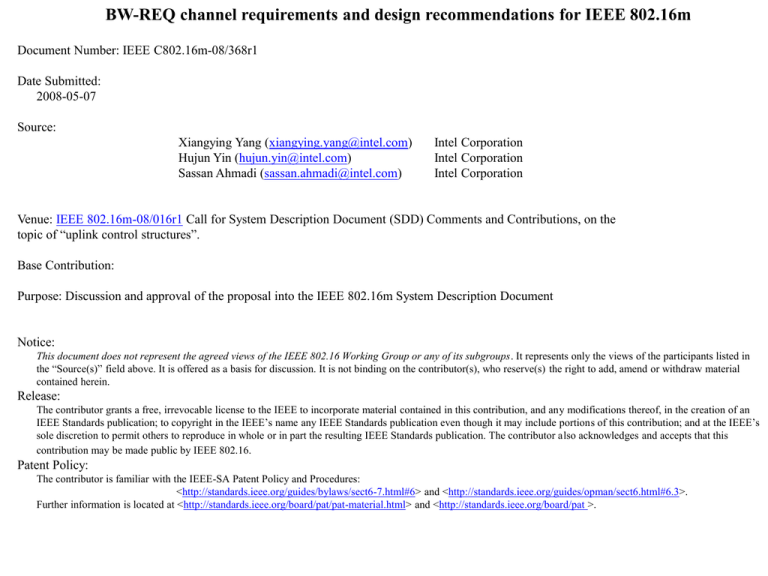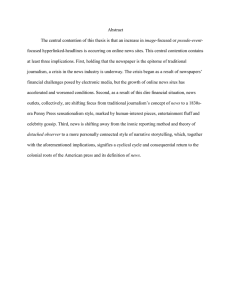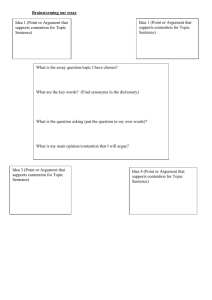BW-REQ channel requirements and design recommendations for IEEE 802.16m
advertisement

BW-REQ channel requirements and design recommendations for IEEE 802.16m Document Number: IEEE C802.16m-08/368r1 Date Submitted: 2008-05-07 Source: Xiangying Yang (xiangying.yang@intel.com) Hujun Yin (hujun.yin@intel.com) Sassan Ahmadi (sassan.ahmadi@intel.com) Intel Corporation Intel Corporation Intel Corporation Venue: IEEE 802.16m-08/016r1 Call for System Description Document (SDD) Comments and Contributions, on the topic of “uplink control structures”. Base Contribution: Purpose: Discussion and approval of the proposal into the IEEE 802.16m System Description Document Notice: This document does not represent the agreed views of the IEEE 802.16 Working Group or any of its subgroups. It represents only the views of the participants listed in the “Source(s)” field above. It is offered as a basis for discussion. It is not binding on the contributor(s), who reserve(s) the right to add, amend or withdraw material contained herein. Release: The contributor grants a free, irrevocable license to the IEEE to incorporate material contained in this contribution, and any modifications thereof, in the creation of an IEEE Standards publication; to copyright in the IEEE’s name any IEEE Standards publication even though it may include portions of this contribution; and at the IEEE’s sole discretion to permit others to reproduce in whole or in part the resulting IEEE Standards publication. The contributor also acknowledges and accepts that this contribution may be made public by IEEE 802.16. Patent Policy: The contributor is familiar with the IEEE-SA Patent Policy and Procedures: <http://standards.ieee.org/guides/bylaws/sect6-7.html#6> and <http://standards.ieee.org/guides/opman/sect6.html#6.3>. Further information is located at <http://standards.ieee.org/board/pat/pat-material.html> and <http://standards.ieee.org/board/pat >. BW-REQ in the reference system BW-REQ procedure – – – – • CDMA (truncated 144-bit PN code) contention CDMA_IE allocation for BW-REQ message BW-REQ message UL grant allocation for UL data CDMA contention What can be improved? – There is no collision resolution; contention failure only recovers from timer expiration. MS – All BW-REQ goes through the 3-step procedure with long latency. This procedure is fine for best-effort traffic, but may not be suitable for delay-sensitive signaling/traffic. BW-REQ message Scheduling delay – Code design is same as initial ranging. However, BW-REQ has quite different requirements from initial ranging. CDMA_IE allocation BS • UL grant UL transmission Higher IEEE 802.16m requirement on BW-REQ IEEE 802.16m system requirements from SRD [1] • High application capacity – – • Low latency – – • Lead to high UL signaling load from L2/L3, which likely needs BW-REQ BW-REQ generates higher load to contention channel Tight requirement on state transition or handover latency Good E2E performance and SE desire low UL access latency High mobility support: upto 350Km/hr – – Small channel coherence time, timing/frequency offset and power control errors Robust contention detection performance Our view, IEEE 802.16m requirements on BW-REQ are in two aspects • Contention channel (PHY) – – – • Sufficient contention capacity Good detection performance in various loads Robust detection performance in various channel conditions Contention-based BW-REQ protocol (MAC) – – – Allow simpler/faster UL access Provide fast recovery from contention failure or collision Contention management is necessary to handle bursty contention loads Application scenario examples • Use SRD [1] – 10MHz/10MHz FDD – 60 VoIP calls/MHz/sector, – 2.6bps/Hz/sector DL SE requirement (TCP), 75% loading • Use EMD [2] to define the following traffic patterns – Call setup for VoIP application session • BW-REQ only at the beginning of each session • At most 40ms UL access delay to meet 50ms delay bound (10ms budget for HARQ latency) – UL access for on-off applications • BW-REQ when offon switch to obtain UL grant • Assume push-to-talk type of traffic • At most 40ms UL access delay to meet 50ms delay bound – UL L3 signaling for DL TCP applications • BW-REQ when TCP ACK sent in uplink • Assume no opportunity for piggybacking BW-REQ • 500ms UL access delay to avoid TCP timeout (100ms downlink, 400ms backbone RTT) Capacity requirement (# detections) • • Contention channel capacity requirement 20 call setup on-off UL access TCP ACK 15 10 5 0 5 10 15 BW-REQ contention channel interval (ms) Call setup offers marginal contention load Challenging to support On-off UL access in the reference system – allocation is required every <10ms • • Heavy downlink TCP data traffic causes huge contention load Required contention resource depends on both: – contention channel capacity requirement – Latency requirement 20 Required contention resources Contention channel resource requirement • 60 call setup on-off UL access TCP ACK 40 20 0 5 10 15 BW-REQ contention channel interval (ms) 20 contention resource measures – # of separated physical (time/frequency) allocations – # of (quasi-)orthogonal code words • Assume a multi-slot ALOHA model, contention resource measured in slots. – Assume all contenders, will be detected. – Collision happens if >1 MSS pick the same slot. • Practically, detection probability is <1 and decreases in load, thus the requirement is much more stringent! Lesson learned from the application examples • When delay or success probability is a concern (e.g., see on-off UL access case) – Tight QoS constraint causes required contention resource increase non-linearly in BW-REQ interval – Better allocate more frequently to reduce overhead • TCP case has relaxed QoS requirement but it has high load – In any case, require sufficient allocation for contention – When consider practical detection performance drops in load, required allocation will be more and increase non-linearly • Generally – Much more demanding in capacity and latency than the reference system! – To be scalable to traffic mix and bandwidth, the design should be flexible BW-REQ contention channel PHY design targets and recommendations Design targets for BW-REQ contention channel • handle 0.1~0.15/ms/FDD-MHz contention load • <1% overhead for BW-REQ contention channel (comparable to the reference system) • Below target load, success probability >90% SDD Recommendations • Use a BW-REQ design different from initial ranging – Detection performance optimized for relatively low timing/frequency offset – Good performance in frequency-selective or fast fading channels – A channel design suitable for large dynamic range of contention loads • Contention channel allows flexible allocation of logical contention resources – Scalable to different bandwidth – Robust/adaptive to traffic dynamics BW-REQ MAC protocol design target • Min UL access delay – Definition: from contention to UL transmission – Desire to achieve the fast turn-around – Target: 10ms in IEEE 802.16m frame structure defined in SDD[1], suitable for delay-sensitive bursty traffic and signaling • Average UL access delay – Guaranteed by PHY contention success probability • Max recovery delay – Definition: from failed contention to retry – 40ms, allowed by the delay bound of delay-sensitive traffic/signaling – MS can retry 2nd time within 40ms, making overall failure probability <1% BW-REQ MAC protocol improvement Possible improvements for current protocols • Contention resolution • Quick access – Enable fast recovery – Fall-back mode for quick access – Reduce further resource waste – Avoid one round-trip – Reduce signaling overhead Contention Contention with embeded BW_REQ Contention_IE allocation BS No need to wait for timer UL transmission MS UL grant or contention_IE allocation MS BS BW-REQ message ACK BW-REQ Retry contention, if not ACKed Contention-based BW-REQ MAC protocol SDD recommendations • Quick access option – Reduce latency by using 2-step UL access – through piggybacking information in contention code, possibly indicating • • • • Rough buffer level BW-REQ for particular signaling User/group identity QoS class • Enable efficient contention resolution – MS can recover from contention failure faster • Enable contention management – BS estimation of contention load – QoS based contention priority – MS back-off pattern Text Proposal to IEEE 802.16m SDD Insert the following text into MAC Layer clause (Chapter 10 in [IEEE 802.16m-08/003r1]) ------------------------------- Text Start ------------------------------10.x.x.x Contention-based bandwidth procedure The contention-based bandwidth request protocol provides both the 2-step quick access method and the 3-step regular access method, as shown in Figure 10.x.1 The regular access method is used independently or as fallback mode for quick access method. The BS provides contention resolution information for the MS to early recover from collision during contention or bandwidth request failure, as shown in Figure 10.x.2,. The BS measures the contention load from bandwidth request ranging channel. Based on the estimated load, the BS adaptively controls the contention channel resource allocation. The BS broadcasts the information associated with contention channel allocation and contention management parameters in downlink control channel. The MS determines its contention/back-off strategy based on the downlink broadcast information. ------------------------------- Text End -------------------------------- Text Proposal to IEEE 802.16m SDD Insert the following text into MAC Layer clause (Chapter 10 in [IEEE 802.16m-08/003r1]) ------------------------------- Text Start ------------------------------Contention with embeded BW_REQ Contention BW-REQ message MS UL transmission Scheduling delay BS UL grant or contention_IE allocation MS BS Contention_IE allocation UL grant UL transmission Figure 10.x.1 2-step quick access (left) and 3-step regular access (right) BW-REQ methods Contention Contention_IE allocation BW-REQ message BS MS No need to wait for timer ACK BW-REQ Retry contention, if not ACKed Figure 10.x.2 Contention resolution in BW-REQ ------------------------------- Text End -------------------------------- Text Proposal to IEEE 802.16m SDD Insert the following text into Physical Layer clause (Chapter 11 in [IEEE 802.16m-08/003r1]) ------------------------------- Text Start ------------------------------11.x.x.x Uplink ranging channel for bandwidth request Uplink ranging channel for bandwidth request uses a different design from initial/periodical ranging. Bandwidth request ranging channel is optimized for detection under small timing/frequency offset, which is bounded by periodical ranging operation. Coherent or non-coherent detection in bandwidth request ranging channel is FFS. Information associated with uplink access request is carried during contention when the MS chooses quick access method. The BS can adjust the resource allocation, i.e., intervals of contention opportunities and time/frequency resource occupancy of each allocation instance, for bandwidth request ranging channel. ------------------------------- Text End ------------------------------- References [1] IEEE 802.16m-07/002r4, “TGm System Requirements Document (SRD)” [2] IEEE 802.16m-08/004r1, “Project 802.16m Evaluation Methodology Document (EMD)”


